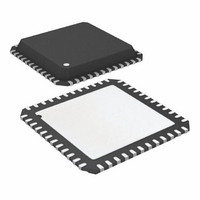AT32UC3B1256-Z1UR Atmel, AT32UC3B1256-Z1UR Datasheet - Page 325

AT32UC3B1256-Z1UR
Manufacturer Part Number
AT32UC3B1256-Z1UR
Description
MCU AVR32 256K FLASH 48-QFN
Manufacturer
Atmel
Series
AVR®32 UC3r
Datasheet
1.AT32UC3B164-AUR.pdf
(680 pages)
Specifications of AT32UC3B1256-Z1UR
Package / Case
48-QFN Exposed Pad
Voltage - Supply (vcc/vdd)
1.65 V ~ 1.95 V
Operating Temperature
-40°C ~ 85°C
Speed
60MHz
Number Of I /o
28
Core Processor
AVR
Program Memory Type
FLASH
Ram Size
32K x 8
Program Memory Size
256KB (256K x 8)
Data Converters
A/D 6x10b
Oscillator Type
Internal
Peripherals
Brown-out Detect/Reset, DMA, POR, PWM, WDT
Connectivity
I²C, IrDA, SPI, SSC, UART/USART, USB
Core Size
32-Bit
Lead Free Status / RoHS Status
Lead free / RoHS Compliant
Eeprom Size
-
- Current page: 325 of 680
- Download datasheet (10Mb)
Figure 21-27. Receiver Behavior when Operating with Hardware Handshaking
32059J–12/2010
RXBUFF
Write
RXD
RTS
CR
RXEN = 1
Figure 21-26. Connection with a Remote Device for Hardware Handshaking
Setting the USART to operate with hardware handshaking is performed by writing the MODE
field in the Mode Register (MR) to the value 0x2.
The USART behavior when hardware handshaking is enabled is the same as the behavior in
standard synchronous or asynchronous mode, except that the receiver drives the RTS pin as
described below and the level on the CTS pin modifies the behavior of the transmitter as
described below. Using this mode requires using the Peripheral DMA Controller channel for
reception. The transmitter can handle hardware handshaking in any case.
Figure 21-27
pin is driven high if the receiver is disabled and if the status RXBUFF (Receive Buffer Full) com-
ing from the Peripheral DMA Controller channel is high. Normally, the remote device does not
start transmitting while its CTS pin (driven by RTS) is high. As soon as the Receiver is enabled,
the RTS falls, indicating to the remote device that it can start transmitting. Defining a new buffer
to the Peripheral DMA Controller clears the status bit RXBUFF and, as a result, asserts the pin
RTS low.
Figure 21-28
pin disables the transmitter. If a character is being processing, the transmitter is disabled only
after the completion of the current character and transmission of the next character happens as
soon as the pin CTS falls.
Figure 21-28. Transmitter Behavior when Operating with Hardware Handshaking
shows how the transmitter operates if hardware handshaking is enabled. The CTS
shows how the receiver operates if hardware handshaking is enabled. The RTS
CTS
TXD
USART
TXD
RXD
CTS
RTS
RXD
TXD
RTS
CTS
Remote
Device
RXDIS = 1
AT32UC3B
325
Related parts for AT32UC3B1256-Z1UR
Image
Part Number
Description
Manufacturer
Datasheet
Request
R

Part Number:
Description:
DEV KIT FOR AVR/AVR32
Manufacturer:
Atmel
Datasheet:

Part Number:
Description:
INTERVAL AND WIPE/WASH WIPER CONTROL IC WITH DELAY
Manufacturer:
ATMEL Corporation
Datasheet:

Part Number:
Description:
Low-Voltage Voice-Switched IC for Hands-Free Operation
Manufacturer:
ATMEL Corporation
Datasheet:

Part Number:
Description:
MONOLITHIC INTEGRATED FEATUREPHONE CIRCUIT
Manufacturer:
ATMEL Corporation
Datasheet:

Part Number:
Description:
AM-FM Receiver IC U4255BM-M
Manufacturer:
ATMEL Corporation
Datasheet:

Part Number:
Description:
Monolithic Integrated Feature Phone Circuit
Manufacturer:
ATMEL Corporation
Datasheet:

Part Number:
Description:
Multistandard Video-IF and Quasi Parallel Sound Processing
Manufacturer:
ATMEL Corporation
Datasheet:

Part Number:
Description:
High-performance EE PLD
Manufacturer:
ATMEL Corporation
Datasheet:

Part Number:
Description:
8-bit Flash Microcontroller
Manufacturer:
ATMEL Corporation
Datasheet:

Part Number:
Description:
2-Wire Serial EEPROM
Manufacturer:
ATMEL Corporation
Datasheet:










